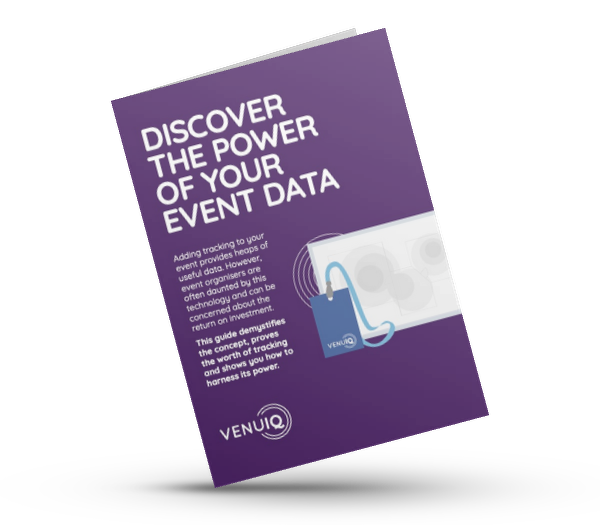In the evolving event management landscape, emerging technologies quietly reshape how we plan, execute, and experience events. Amongst the new technologies, Bluetooth tracking stands out as a game changer, ushering in a silent revolution. This technology is refining and redefining event management processes for event managers, event organisers, conference planners, exhibition organisers, and venue managers. This article explores the impact of Bluetooth tracking on event management.
Let’s look at the main impacts of Bluetooth tracking on events:
1. Enhancing the Guest Experience
Bluetooth tracking facilitates a seamless guest experience. By utilising Bluetooth Low Energy (BLE) beacons, event organisers can offer real-time navigation and personalised experiences. Attendees can effortlessly navigate through large venues and locate booths and sessions, all while receiving personalised suggestions and updates on their smartphones through an event app.
Real-Time Navigation and Information:
Bluetooth Low Energy (BLE) beacons placed strategically throughout the venue interact with attendees’ smartphones, providing real-time navigation assistance. This is invaluable in large venues where finding specific booths, stages, or amenities can be challenging. Real-time updates regarding ongoing or upcoming sessions, schedule changes, or important announcements can be pushed directly to attendees’ devices, keeping them informed and engaged.
Personalised Experiences:
Bluetooth tracking allows for creating personalised experiences based on an attendee’s location within the venue. For instance, as attendees approach a particular booth or exhibit, personalised information about the exhibit or special offers can be sent to their event app or a smartphone notification. This level of personalisation enhances engagement and makes the event more enjoyable and meaningful for each attendee.
Interactive Zones:
Bluetooth technology enables the creation of interactive zones within the event venue. These zones can facilitate networking and interactions among attendees with shared interests. For example, a ‘Business Matchmaking Zone’ could connect attendees with potential business partners or clients based on their profiles and preferences. Such interactions not only enrich the event experience but also contribute to achieving the attendees’ individual objectives.
Enhanced Accessibility:
For individuals with disabilities, navigating through crowded event spaces can be daunting. Bluetooth tracking can provide tailored navigation assistance, ensuring a more accessible and enjoyable experience for all attendees.
Feedback Collection:
Bluetooth tracking can also facilitate real-time feedback collection. As attendees leave a session or an exhibit, a feedback prompt can be sent to their smartphones, allowing event organisers to collect valuable insights on the attendees’ experience, which can be used to make real-time adjustments or better plan for future events.
Using Bluetooth tracking technology is not merely a step but a giant leap towards creating memorable and enriching event experiences. Its ability to provide real-time navigation, personalised interactions, enhanced accessibility, and invaluable feedback makes it a powerful tool in modern event management aimed at exceeding attendees’ expectations.
See Bluetooth Tracking in action
Talk to the VenuIQ team about a demonstration of Bluetooth tracking and its capabilities.

2. Streamlining Operations
Operational efficiency is crucial for the success of any event and the future renewal of an event. Bluetooth tracking enables real-time monitoring and analysis of crowd movements, and this data is invaluable for making informed decisions on the fly regarding staffing, security, and crowd management, ensuring smooth operations throughout the event.
Real-Time Crowd Monitoring:
With Bluetooth Low Energy (BLE) beacons strategically placed throughout the venue, event organisers can monitor crowd movements in real-time. This is crucial for managing crowd flow, preventing overcrowding, and ensuring a safe and comfortable environment for attendees.
Staffing Optimisation:
By analysing the real-time data collected through Bluetooth tracking, event organisers can make informed decisions regarding staffing levels. For instance, if a particular venue area is getting crowded, additional staff can be deployed to manage the crowd or provide assistance. This proactive approach ensures that resources are allocated efficiently, enhancing operational effectiveness.
Security Enhancement:
Bluetooth tracking can play a pivotal role in enhancing security at events. By monitoring the movement and gathering of attendees, security personnel can swiftly respond to potential issues. Moreover, in case of emergencies, having real-time data on crowd locations can be invaluable for evacuation planning and ensuring the safety of attendees.
Resource Distribution:
Understanding where and when attendees congregate allows for smarter resource distribution. Whether it’s positioning food and beverage stations, restrooms, or other amenities, data from Bluetooth tracking can inform the placement of these resources to meet attendees’ needs effectively.
Traffic Flow Management:
By analysing the movement patterns of attendees, event organisers can identify bottlenecks and optimise traffic flow within the venue. This could involve adjusting the event’s layout or providing directional guidance to attendees through their smartphones.
Operational Insights for Future Planning:
The data collected through Bluetooth tracking isn’t just valuable for real-time decision-making; it’s a goldmine for future event planning. By analysing attendees’ movement patterns and behaviours, organisers can gain insights into what worked well and what didn’t, providing a strong foundation for making data-driven decisions in planning subsequent events.
Bluetooth tracking technology is a must for streamlining operations in modern event management. Its ability to provide real-time insights into crowd movements and behaviours allows for proactive operational decision-making, ensuring a smooth, safe, and enjoyable event experience. Additionally, the rich data collected serves as an invaluable resource for future event planning, driving continual improvement and success in the ever-evolving realm of event management.
3. Boosting Engagement and Interaction
Events thrive on the engagement and interaction among attendees. Bluetooth technology allows for the creation of interactive zones, enhancing networking opportunities. By setting up BLE beacons, organisers can foster meaningful interactions by connecting attendees with similar interests or facilitating business matchmaking.
Creation of Interactive Zones:
Bluetooth technology facilitates the creation of interactive zones within the event venue. By setting up Bluetooth Low Energy (BLE) beacons, organisers can create designated areas where attendees can engage in discussions, networking, or explore shared interests. These zones can host activities like business matchmaking, thematic discussions, or even interactive exhibitions, fostering meaningful interactions among attendees.
Real-Time Networking Opportunities:
Bluetooth tracking can facilitate real-time networking by connecting attendees with similar interests or complementary business needs. For instance, an app integrated with Bluetooth technology can notify attendees about potential networking opportunities based on their profiles and proximity, thus fostering meaningful connections effortlessly.
Enhanced Exhibitor-Attendee Interaction:
Exhibitors can utilize Bluetooth technology to engage attendees as they approach their booths. They can send personalized notifications about their products or services or even offer live demonstrations. This real-time interaction can significantly enhance the engagement level and provide a more enriching experience for both exhibitors and attendees.
Gamification and Interactive Experiences:
Bluetooth technology can create gamified experiences that encourage interaction and engagement. For example, organisers could set up a scavenger hunt where attendees interact with BLE beacons at various points within the venue to collect points or rewards. Gamified interactions can make the event more enjoyable and memorable.
Bluetooth tracking technology is a powerhouse for boosting engagement and interaction during events. Its versatility in creating interactive zones, facilitating real-time networking, enhancing exhibitor-attendee interaction, and enabling gamified experiences makes it an indispensable tool for modern event management. By embracing Bluetooth technology, event organisers can craft events that are not only enjoyable but also conducive to meaningful interactions and networking, significantly enriching the overall event experience.
4. Measuring Event Performance
The analytical aspect of Bluetooth tracking provides a goldmine of data. By analysing attendees’ behaviour and movement patterns, organisers can measure the success and ROI of the event. This data can also be leveraged for planning future events, providing insights into attendees’ preferences and areas of improvement.
Real-Time Data Collection:
Bluetooth tracking technology allows real-time data collection on various metrics such as attendee movement patterns, booth visit frequencies, and session attendance. This real-time data provides a live snapshot of the event’s performance, enabling organisers to make informed decisions during an event.
Attendee Behavior Analysis:
By analysing the data collected through Bluetooth tracking, organisers can gain insights into attendee behaviours and preferences. Understanding which sessions were most attended, which booths were most visited, and how attendees navigated through the venue provides a wealth of information for evaluating the event’s success and areas of improvement.
Performance Metrics:
Bluetooth tracking enables the measurement of key performance metrics such as dwell times, peak visit times, and crowd density at different locations within the venue. These metrics are essential for evaluating the event’s performance against predefined goals and objectives.
Feedback Loop:
Bluetooth technology can also facilitate real-time feedback collection from attendees. This immediate feedback, coupled with the behavioural data collected, provides a comprehensive view of the event’s performance from both objective and subjective perspectives.
Return on Investment (ROI) Analysis:
The data gathered through Bluetooth tracking can be instrumental in conducting a thorough ROI analysis. By evaluating the engagement levels, attendee satisfaction, and other key metrics, organisers can measure the ROI of the event, which is critical for stakeholders and for planning future events.
Download the “Discover the Power of Your Event Data” guide
You can learn more about Bluetooth tracking and how to harness its power for your next event with this FREE guide. “Discover The Power of Your Event Data” is packed full of the technical information you need, real event case studies, and the views of fellow event organisers. Plus, you’ll discover how you can build a powerful case for the return on investment of your event for your event stakeholders from the tracking data collected.
FIND OUT MORE
Future Event Planning:
The insights gained from analysing the event’s performance can be invaluable for planning future events. Understanding what worked well and what didn’t allows for data-driven decision-making in designing the layout, scheduling sessions, allocating resources, and setting realistic goals for future events.
Bluetooth tracking technology enables measuring event performance accurately and effectively. Its ability to provide real-time data, analyse attendee behaviour, measure key performance metrics, and facilitate a feedback loop makes it an indispensable tool for modern event managers.
5. Ensuring Health and Safety
While the Covid pandemic may now be behind us, Bluetooth tracking and Bluetooth-enabled devices were absolutely necessary during a socially distanced world. VenuIQ’s safewatch invention is an incredible use of Bluetooth technology to keep guests apart when measures were in place, ensuring events could take place and regulations adhered to.
In a post-pandemic world, health and safety is still paramount. Bluetooth tracking can aid in contact tracing and ensuring adherence to social distancing guidelines, providing a safer environment for all attendees.
Contact Tracing:
Bluetooth tracking technology can be utilised for contact tracing, which is crucial for identifying and notifying individuals who may have come into contact with a person diagnosed with a contagious disease. By keeping a log of interactions between attendees, organisers can quickly respond to health concerns, helping to mitigate the spread of infectious diseases.
Social Distancing Monitoring:
In events where maintaining social distance is crucial, Bluetooth technology can help monitor and enforce social distancing guidelines. By analyzing the proximity data collected through Bluetooth beacons, organizers can identify areas where social distancing measures are not being adhered to and take corrective actions such as redistributing attendees or modifying the layout.
Capacity Monitoring:
Bluetooth tracking can provide real-time data on the number of attendees in different areas of the venue, helping organizers ensure compliance with capacity restrictions. This is particularly important in enclosed spaces or popular exhibits where overcrowding can pose health and safety risks.
Emergency Response:
In an emergency, Bluetooth tracking technology can provide real-time data on attendees’ locations, aiding in effective evacuation planning. Additionally, emergency notifications can be sent directly to attendees’ smartphones, providing them with important information and instructions.
Health Checkpoints:
Bluetooth technology can set up health checkpoints at the entrance and throughout the venue. Attendees can receive notifications on their smartphones reminding them to visit these checkpoints for regular health checks, like temperature screenings or symptom checks.
Improved Sanitation:
By analysing movement patterns, organisers can identify high-traffic areas that may require more frequent cleaning and sanitation. Moreover, reminders for hand sanitisation can be sent to attendees as they move through the venue, promoting a clean and safe environment.
Bluetooth tracking technology is a formidable asset in ensuring health and safety during events. Its capabilities in contact tracing, social distancing monitoring, capacity monitoring, and aiding emergency response are indispensable in the current scenario. By leveraging Bluetooth technology, event organisers can significantly enhance health and safety protocols, providing a secure and comfortable environment for attendees. This not only ensures compliance with health guidelines but also reinstates trust among attendees, which is crucial for the success of any event in the post-pandemic world.
Empirical Evidence for Bluetooth Tracking
Bluetooth tracking technology has been utilised in various events to analyse the spatiotemporal dynamics of human movement, offering a rich data set for event managers to improve operational efficiencies and enhance attendees’ experience. Here are some insights from specific events that have employed Bluetooth tracking:
- Ghent Festivities Case Study: A study conducted during the Ghent Festivities analyzed the spatiotemporal dynamics of human movement at the event using Bluetooth technology. The study aimed to understand crowd movements and behaviors during mass events to improve event management strategies in the future1.
- Tour of Flanders 2011 Case Study: During the Tour of Flanders 2011, a significant cycling event, Bluetooth tracking was employed to map the movement of spectators. The methodology and findings from this event were documented, although the detailed insights are not publicly available due to restrictions on accessing the source document2.
- Walt Disney World Resort Case Study: The Walt Disney World Resort utilised Bluetooth and Mist AI to enhance its operations. Although not a conventional event, the application of Bluetooth technology in such a large-scale and high-traffic environment demonstrates the potential benefits for event managers3.
- The Annual Hotel Conference (AHC): The AHC used VenuIQ’s Bluetooth tracking solution to deliver its 2022 conference at the Manchester Central Convention Complex. Questex, the event organiser, used the live tracking data of more than 1000 delegates to discover how many people were on-site, where was most popular, and how well sessions were attended. In addition, heatmaps were provided to see how people moved around the show. For exhibitors, stand traffic and dwell time, seniority averages, demographics and more were provided.4
These case studies and insights underline the potential of Bluetooth tracking in providing real-time data that can be leveraged for better decision-making during events and for future planning. By understanding crowd dynamics and attendees’ behaviours, event managers can optimise staffing, security arrangements, and overall event layout to ensure a smooth and engaging experience for attendees.
Summary
The silent revolution of Bluetooth tracking is shaping the future of event management. Its ability to enhance the guest experience, streamline operations, boost engagement, measure performance, and ensure health and safety makes it an indispensable tool in the modern event manager’s toolkit. As we embrace this technology, the horizon of what’s achievable in event management expands, promising more engaging, efficient, and safe events for all stakeholders.
